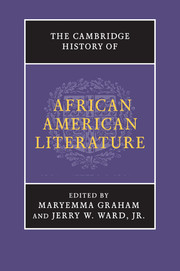Book contents
- Frontmatter
- Introduction
- PART I AFRICAN AMERICAN LITERATURE FROM ITS ORIGINS TO THE TWENTIETH CENTURY
- PART II AFRICAN AMERICAN LITERATURE IN THE TWENTIETH CENTURY
- 12 Foundations of African American modernism, 1910–1950
- 13 The New Negro Movement and the politics of art
- 14 African American literature and the Great Depression
- 15 Weaving jagged words: the black Left, 1930s–1940s
- 16 Writing the American story, 1945–1952
- 17 Geographies of the modern: writing beyond borders and boundaries
- 18 African American literature by writers of Caribbean descent
- 19 Reform and revolution, 1965–1976: the Black Aesthetic at work
- 20 History as fact and fiction
- 21 Redefining the art of poetry
- 22 Cultural resistance and avant-garde aesthetics: African American poetry from 1970 to the present
- 23 New frontiers, cross-currents and convergences: emerging cultural paradigms
- PART III AFRICAN AMERICAN LITERATURE AS ACADEMIC AND CULTURAL CAPITAL
- Bibliography
- Index
- References
17 - Geographies of the modern: writing beyond borders and boundaries
from PART II - AFRICAN AMERICAN LITERATURE IN THE TWENTIETH CENTURY
Published online by Cambridge University Press: 28 May 2011
- Frontmatter
- Introduction
- PART I AFRICAN AMERICAN LITERATURE FROM ITS ORIGINS TO THE TWENTIETH CENTURY
- PART II AFRICAN AMERICAN LITERATURE IN THE TWENTIETH CENTURY
- 12 Foundations of African American modernism, 1910–1950
- 13 The New Negro Movement and the politics of art
- 14 African American literature and the Great Depression
- 15 Weaving jagged words: the black Left, 1930s–1940s
- 16 Writing the American story, 1945–1952
- 17 Geographies of the modern: writing beyond borders and boundaries
- 18 African American literature by writers of Caribbean descent
- 19 Reform and revolution, 1965–1976: the Black Aesthetic at work
- 20 History as fact and fiction
- 21 Redefining the art of poetry
- 22 Cultural resistance and avant-garde aesthetics: African American poetry from 1970 to the present
- 23 New frontiers, cross-currents and convergences: emerging cultural paradigms
- PART III AFRICAN AMERICAN LITERATURE AS ACADEMIC AND CULTURAL CAPITAL
- Bibliography
- Index
- References
Summary
The trajectory of twentieth-century African American literature in the post-Second World War decades is generally assumed to work something like this: starting with Richard Wright, one will move to Ralph Ellison, maybe linger some on Zora Neale Hurston, hover over the Black Arts Movement and Le Roi Jones/Amiri Baraka, then jump to Alice Walker, and crown the narrative with Toni Morrison. Depending upon particular interest, a few names might be added such as Gwendolyn Brooks, James Baldwin, Chester Himes, Alex Haley, Ishmael Reed, and Nikki Giovanni, for example. Therefore, the wealth and variety of African American writing published on the heels of Richard Wright, and before the creative explosions of the Black Arts Movement in the late 1960s and womanist writing in the 1970s and 1980s, might come as a surprise for some. Since the 1980s there has been a growing market for and greater mainstream scholarly recognition of this sizeable body of work. As early as 1979, Gayl Jones captured the richness she believed to be unique in earlier black literature, calling our attention to its “speech and music continuum. Jazz. Sermon. Incantation. Words as voice heard and music. Whole range of Black speech and music. Ritual. A constant movement and flowing into. Magic song and sound and voice. Constant movement between different kinds of language. Social reality in whole form – history.”
- Type
- Chapter
- Information
- The Cambridge History of African American Literature , pp. 356 - 376Publisher: Cambridge University PressPrint publication year: 2011

